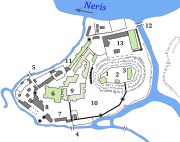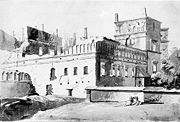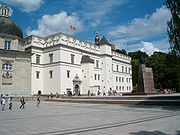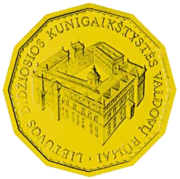
Royal Palace of Lithuania
Encyclopedia


Lithuania
Lithuania , officially the Republic of Lithuania is a country in Northern Europe, the biggest of the three Baltic states. It is situated along the southeastern shore of the Baltic Sea, whereby to the west lie Sweden and Denmark...
was a palace in Vilnius
Vilnius
Vilnius is the capital of Lithuania, and its largest city, with a population of 560,190 as of 2010. It is the seat of the Vilnius city municipality and of the Vilnius district municipality. It is also the capital of Vilnius County...
, Lithuania
Lithuania
Lithuania , officially the Republic of Lithuania is a country in Northern Europe, the biggest of the three Baltic states. It is situated along the southeastern shore of the Baltic Sea, whereby to the west lie Sweden and Denmark...
, built in the 15th century for the rulers of the Grand Duchy of Lithuania
Grand Duchy of Lithuania
The Grand Duchy of Lithuania was a European state from the 12th /13th century until 1569 and then as a constituent part of Polish-Lithuanian Commonwealth until 1791 when Constitution of May 3, 1791 abolished it in favor of unitary state. It was founded by the Lithuanians, one of the polytheistic...
. The Royal Palace in the Lower Castle evolved over the years and prospered during the 16th and mid-17th centuries. For four centuries the Palace was the political, administrative and cultural center of the Grand Duchy of Lithuania
Grand Duchy of Lithuania
The Grand Duchy of Lithuania was a European state from the 12th /13th century until 1569 and then as a constituent part of Polish-Lithuanian Commonwealth until 1791 when Constitution of May 3, 1791 abolished it in favor of unitary state. It was founded by the Lithuanians, one of the polytheistic...
. It was demolished in 1801. A new palace has been under construction since 2002 on the site of the original building. The partially completed palace was opened on 6 July 2009.
History
In the 13th and 14th centuries there were stoneMasonry
Masonry is the building of structures from individual units laid in and bound together by mortar; the term masonry can also refer to the units themselves. The common materials of masonry construction are brick, stone, marble, granite, travertine, limestone; concrete block, glass block, stucco, and...
structures within the palace site; some archeologists believe that a wooden palace stood there as well. The stone Royal Palace was built in the 15th century, apparently after the major fire in 1419. The existing stone buildings and defensive structures of the Lower Castle, which blocked the construction, were demolished. The Royal Palace was built in Gothic
Gothic architecture
Gothic architecture is a style of architecture that flourished during the high and late medieval period. It evolved from Romanesque architecture and was succeeded by Renaissance architecture....
style. The Keep
Keep
A keep is a type of fortified tower built within castles during the Middle Ages by European nobility. Scholars have debated the scope of the word keep, but usually consider it to refer to large towers in castles that were fortified residences, used as a refuge of last resort should the rest of the...
of the Upper Castle, as well as the Royal Palace, were meant to host the coronation
Coronation
A coronation is a ceremony marking the formal investiture of a monarch and/or their consort with regal power, usually involving the placement of a crown upon their head and the presentation of other items of regalia...
of Vytautas the Great
Vytautas the Great
Vytautas ; styled "the Great" from the 15th century onwards; c. 1350 October 27, 1430) was one of the most famous rulers of medieval Lithuania. Vytautas was the ruler of the Grand Duchy of Lithuania which chiefly encompassed the Lithuanians and Ruthenians...
. The Gothic
Gothic architecture
Gothic architecture is a style of architecture that flourished during the high and late medieval period. It evolved from Romanesque architecture and was succeeded by Renaissance architecture....
palace
Palace
A palace is a grand residence, especially a royal residence or the home of a head of state or some other high-ranking dignitary, such as a bishop or archbishop. The word itself is derived from the Latin name Palātium, for Palatine Hill, one of the seven hills in Rome. In many parts of Europe, the...
had three wings; research suggests that it was a two-story building with a basement.
The Grand Duke of Lithuania Alexander
Alexander Jagiellon
Alexander of the House of Jagiellon was the Grand Duke of Lithuania and later also King of Poland. He was the fourth son of Casimir IV Jagiellon...
, who later became King of Poland
Poland
Poland , officially the Republic of Poland , is a country in Central Europe bordered by Germany to the west; the Czech Republic and Slovakia to the south; Ukraine, Belarus and Lithuania to the east; and the Baltic Sea and Kaliningrad Oblast, a Russian exclave, to the north...
, moved his residence to the Royal Palace, where he met with ambassadors. He ordered the renovation of the palace. After his marriage to a daughter of Moscow's Grand Duke
Grand Duchy of Moscow
The Grand Duchy of Moscow or Grand Principality of Moscow, also known in English simply as Muscovy , was a late medieval Rus' principality centered on Moscow, and the predecessor state of the early modern Tsardom of Russia....
Ivan III, the royal couple lived and died in the palace.
Sigismund I the Old
Sigismund I the Old
Sigismund I of Poland , of the Jagiellon dynasty, reigned as King of Poland and also as the Grand Duke of Lithuania from 1506 until 1548...
, after his ascension to the Grand Duchy of Lithuania
Grand Duchy of Lithuania
The Grand Duchy of Lithuania was a European state from the 12th /13th century until 1569 and then as a constituent part of Polish-Lithuanian Commonwealth until 1791 when Constitution of May 3, 1791 abolished it in favor of unitary state. It was founded by the Lithuanians, one of the polytheistic...
, conducted his affairs in the Royal Palace as well as in Vilnius Cathedral
Vilnius Cathedral
The Cathedral of Vilnius is the main Roman Catholic Cathedral of Lithuania.It is situated in Vilnius Old Town, just off of Cathedral Square. It is the heart of Lithuania's Catholic spiritual life....
. During the rule of Sigismund I the palace was greatly expanded, to meet new needs of the Grand Duke – another wing was added, as well as a third floor; the gardens were also extended. By contemporary accounts the palace was worth 100,000 ducat
Ducat
The ducat is a gold coin that was used as a trade coin throughout Europe before World War I. Its weight is 3.4909 grams of .986 gold, which is 0.1107 troy ounce, actual gold weight...
s. The palace reconstruction plan was probably prepared by Italian
Italy
Italy , officially the Italian Republic languages]] under the European Charter for Regional or Minority Languages. In each of these, Italy's official name is as follows:;;;;;;;;), is a unitary parliamentary republic in South-Central Europe. To the north it borders France, Switzerland, Austria and...
architect
Architect
An architect is a person trained in the planning, design and oversight of the construction of buildings. To practice architecture means to offer or render services in connection with the design and construction of a building, or group of buildings and the space within the site surrounding the...
Bartolomeo Berrecci da Pontassieve, who also designed several other projects in the Kingdom of Poland
Kingdom of Poland (1385–1569)
The Kingdom of Poland of the Jagiellons was the Polish state created by the accession of Jogaila , Grand Duke of Lithuania, to the Polish throne in 1386. The Union of Krewo or Krėva Act, united Poland and Lithuania under the rule of a single monarch...
. In this palace Sigismund the Old welcomed an emissary from the Holy Roman Empire
Holy Roman Empire
The Holy Roman Empire was a realm that existed from 962 to 1806 in Central Europe.It was ruled by the Holy Roman Emperor. Its character changed during the Middle Ages and the Early Modern period, when the power of the emperor gradually weakened in favour of the princes...
, who introduced Sigismund to Bona Sforza
Bona Sforza
Bona Sforza was a member of the powerful Milanese House of Sforza. In 1518, she became the second wife of Sigismund I the Old, the King of Poland and Grand Duke of Lithuania, and became the Queen of Poland and Grand Duchess of Lithuania.She was the third child of Gian Galeazzo Sforza and his wife...
, his second wife, in 1517.
Sigismund's son Sigismund II Augustus
Sigismund II Augustus
Sigismund II Augustus I was King of Poland and Grand Duke of Lithuania, the only son of Sigismund I the Old, whom Sigismund II succeeded in 1548...
was crowned Grand Duke of Lithuania in the Royal Palace. Augustus carried on with palace development and lived there with his first wife Elisabeth of Austria
Elisabeth of Austria (1526-1545)
Elisabeth of Austria was the eldest child of Ferdinand I, Holy Roman Emperor and his wife Anna of Bohemia and Hungary. Elisabeth was a member of the House of Habsburg.- Life :...
, daughter of the Emperor of the Holy Roman Empire
Ferdinand I, Holy Roman Emperor
Ferdinand I was Holy Roman Emperor from 1558 and king of Bohemia and Hungary from 1526 until his death. Before his accession, he ruled the Austrian hereditary lands of the Habsburgs in the name of his elder brother, Charles V, Holy Roman Emperor.The key events during his reign were the contest...
. She was buried in the Vilnius Cathedral
Vilnius Cathedral
The Cathedral of Vilnius is the main Roman Catholic Cathedral of Lithuania.It is situated in Vilnius Old Town, just off of Cathedral Square. It is the heart of Lithuania's Catholic spiritual life....
. Sigismund II's second wife, Barbara Radziwill
Barbara Radziwill
Barbara Radziwiłł was Queen of Poland and Grand Duchess of Lithuania, and consort to King Sigismund II Augustus.- Biography :Barbara was the daughter of a powerful magnate of the Radziwiłł family, castellan, voivode and hetman of the Grand Duchy of Lithuania Jerzy Radziwiłł, and Barbara...
, also lived in the palace. According to contemporary accounts of the Holy See
Holy See
The Holy See is the episcopal jurisdiction of the Catholic Church in Rome, in which its Bishop is commonly known as the Pope. It is the preeminent episcopal see of the Catholic Church, forming the central government of the Church. As such, diplomatically, and in other spheres the Holy See acts and...
's emissary, the Royal Palace at that time contained more treasures than the Vatican. Sigismund II also assembled one of the largest collection of books and tapestries
Jagiellonian tapestries
The so-called Jagiellonian tapestries is collection of tapestries which originally consisted of about 360 fabrics gathered by the Jagiellons to decorate the interiors of the royal residencies...
in Europe.
The palace was remodeled in the Renaissance
Renaissance
The Renaissance was a cultural movement that spanned roughly the 14th to the 17th century, beginning in Italy in the Late Middle Ages and later spreading to the rest of Europe. The term is also used more loosely to refer to the historical era, but since the changes of the Renaissance were not...
style in the 16th century. The plan was prepared by several Italian architects, including Giovanni Cini da Siena, Bernardino de Gianotis Zanobi, and others. The palace was visited by Ippolito Aldobrandini, who later became Pope Clement VIII
Pope Clement VIII
Pope Clement VIII , born Ippolito Aldobrandini, was Pope from 30 January 1592 to 3 March 1605.-Cardinal:...
. Another major development took place during the reign of the Vasa family
House of Vasa
The House of Vasa was the Royal House of Sweden 1523-1654 and of Poland 1587-1668. It originated from a noble family in Uppland of which several members had high offices during the 15th century....
. The Royal Palace was refurbished in early Baroque
Baroque
The Baroque is a period and the style that used exaggerated motion and clear, easily interpreted detail to produce drama, tension, exuberance, and grandeur in sculpture, painting, literature, dance, and music...
style during the rule of Sigismund III Vasa
Sigismund III Vasa
Sigismund III Vasa was King of Poland and Grand Duke of Lithuania, a monarch of the united Polish–Lithuanian Commonwealth from 1587 to 1632, and King of Sweden from 1592 until he was deposed in 1599...
. Matteo Castello, Giacopo Tencalla, and other artists participated in the 17th century renovation.

House of Vasa
The House of Vasa was the Royal House of Sweden 1523-1654 and of Poland 1587-1668. It originated from a noble family in Uppland of which several members had high offices during the 15th century....
s, several notable ceremonies took place in the palace, including the wedding of Duke John, who later became King John III of Sweden
John III of Sweden
-Family:John married his first wife, Catherine Jagellonica of Poland , house of Jagiello, in Vilnius on 4 October 1562. In Sweden, she is known as Katarina Jagellonica. She was the sister of king Sigismund II Augustus of Poland...
, and Sigismund Augustus' sister Catherine. The first opera
Opera
Opera is an art form in which singers and musicians perform a dramatic work combining text and musical score, usually in a theatrical setting. Opera incorporates many of the elements of spoken theatre, such as acting, scenery, and costumes and sometimes includes dance...
in Lithuania was staged in the palace in 1634. Marco Scacchi and Virgilio Puccitelli were the opera's impresarios.
After the Russian invasion in 1655, the state began weakening, and that negatively affected the Royal Palace. In August 1655, Vilnius
Vilnius
Vilnius is the capital of Lithuania, and its largest city, with a population of 560,190 as of 2010. It is the seat of the Vilnius city municipality and of the Vilnius district municipality. It is also the capital of Vilnius County...
was captured by the Muscovite army. The Polish-Lithuanian army recaptured the city six years later, by which time the palace had been destroyed by fire. The palace was greatly damaged and its treasures were plundered. After the recapture of the city of Vilnius in 1660-1661, the palace was no longer a suitable state residence, and stood abandoned for about 150 years. In the late 18th century, after the fall of the Polish-Lithuanian Commonwealth
Polish-Lithuanian Commonwealth
The Polish–Lithuanian Commonwealth was a dualistic state of Poland and Lithuania ruled by a common monarch. It was the largest and one of the most populous countries of 16th- and 17th‑century Europe with some and a multi-ethnic population of 11 million at its peak in the early 17th century...
, several families lived in parts of the ruined palace. Soon after the Grand Duchy of Lithuania was incorporated into Tsarist Russia, Tsarist officials ordered the demolition of the remaining sections of the Royal Palace. The Palace was almost completely demolished in 1801, the bricks and stones were sold, and the site was bowered.

November Uprising
The November Uprising , Polish–Russian War 1830–31 also known as the Cadet Revolution, was an armed rebellion in the heartland of partitioned Poland against the Russian Empire. The uprising began on 29 November 1830 in Warsaw when the young Polish officers from the local Army of the Congress...
, the czarist government expelled Schlossberg and took over the building as it was building a fortress beside it. Before the Second World War it was the office of the Lithuanian Army, during the World War II it was the office of the German Army
Wehrmacht
The Wehrmacht – from , to defend and , the might/power) were the unified armed forces of Nazi Germany from 1935 to 1945. It consisted of the Heer , the Kriegsmarine and the Luftwaffe .-Origin and use of the term:...
, and after WWII it was used by Soviet security structures and later transformed into the Palace of Pioneers
Young Pioneer organization of the Soviet Union
The Young Pioneer Organization of the Soviet Union, also Vladimir Lenin All-Union Pioneer Organization The Young Pioneer Organization of the Soviet Union, also Vladimir Lenin All-Union Pioneer Organization The Young Pioneer Organization of the Soviet Union, also Vladimir Lenin All-Union Pioneer...
. Fragments of Schlossberg's house have become part of the Eastern Wing of the restored Royal Palace.
A new palace has been under construction since 2002 on the site of the original building. The Royal Palace was officially opened during the celebration of the millennium
Millennium
A millennium is a period of time equal to one thousand years —from the Latin phrase , thousand, and , year—often but not necessarily related numerically to a particular dating system....
of the name of Lithuania
Name of Lithuania
The first known record of the name of Lithuania is in a 9 March 1009 story of Saint Bruno recorded in the Quedlinburg Chronicle . The Chronicle recorded a Latinized Slavic form of the name Lietuva: Litua pronounced [litvā]...
in 2009, although not yet completed due to the lack of necessary funding.
Criticism of the reconstruction



